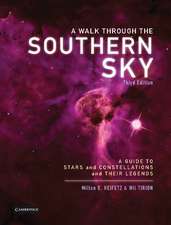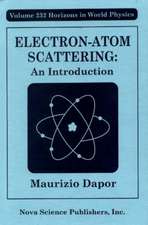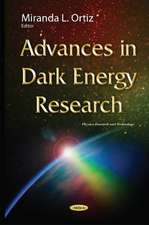The Two-Body Force in Nuclei: Proceedings of the Symposium on the Two-Body Force in Nuclei held at Gull Lake, Michigan, September 7–10, 1971
Editat de S. M. Austinen Limba Engleză Paperback – 24 apr 2012
Preț: 398.15 lei
Nou
Puncte Express: 597
Preț estimativ în valută:
76.21€ • 82.81$ • 64.06£
76.21€ • 82.81$ • 64.06£
Carte tipărită la comandă
Livrare economică 21 aprilie-05 mai
Preluare comenzi: 021 569.72.76
Specificații
ISBN-13: 9781468483390
ISBN-10: 1468483390
Pagini: 412
Ilustrații: XVI, 390 p.
Dimensiuni: 170 x 244 x 22 mm
Greutate: 0.65 kg
Ediția:1972
Editura: Springer Us
Colecția Springer
Locul publicării:New York, NY, United States
ISBN-10: 1468483390
Pagini: 412
Ilustrații: XVI, 390 p.
Dimensiuni: 170 x 244 x 22 mm
Greutate: 0.65 kg
Ediția:1972
Editura: Springer Us
Colecția Springer
Locul publicării:New York, NY, United States
Public țintă
ResearchDescriere
The idea of this symposium grew out of our discussions on the need to review the advances that had been made in the theoretical description of inelastic scattering reactions in the last few years. Since a microscopic description of inelastic scattering uses realistic effective interactions, we felt that it was appropriate to begin such a summary with a discussion of the free two-nucleon force. However as we thought further about this review, it became increasingly apparent that a rather more ambitious program linking the free two-nucleon force and nuclear matter calculations both to shell model calculations and to reaction theory, would be appropriate and perhaps even necessary to do full justice to the subject. We hope that the symposium as it emerged did fulfill these aims, better perhaps than we expected. There are some comments required concerning the presentation of the material. First the papers are grouped by session number for convenient gathering of the same topic in the same place. Secondly, because of the rather tight constraint on pages, it was possible to print only those contributions which were presented orally at the symposium. The remainner are included as abstracts. The full text of all the contributed papers is available as a Michigan State University Cyclotron Laboratory Report (MSUCL 39/1971).
Cuprins
Symposium Overview.- Session I: The Free Two-Nucleon Force.- Phase-Shift and Potential-Model Analysis of Experimental Information (Invited Paper).- Elementary-Particle Models of the Two-Nucleon Force (Invited Paper).- Development of a Super Soft Core Potential Model of the Nucleon-Nucleon Interaction.- Two-Pion-Exchange Nucleon-Nucleon Potential.- The Two-Pion Exchange Contribution to the Nucleon-Nucleon Potential.- On the Definition of a Boson Exchange Potential.- Session II: Off-Energy-Shell Effects.- Review of Experiments on Nucleon-Nucleon Bremsstrahlung (Invited Paper).- Some Basic Questions in Nucleon-Nucleon Bremsstrahlung (Invited Paper).- Off-Energy-Shell Effects in Many-Nucleon Systems (Invited Paper).- Neutron-Proton Bremsstrahlung Including Gauge-Invariant Terms Arising from the Nuclear Potential.- Off-Shell Effects in the 18O and 18F Shell-Model Spectra.- Triton Binding Energy Predictions for Phase-Shift Equivalent Potentials.- Session III: Calculations of the Effective Reaction.- Matrix in Nuclear Matter and Finite Nucle.- An Effective Reaction Matrix Derived from Nuclear Matter Calculations (Invited Paper).- The Effective Two-Body Interaction in Finite Nuclei and its Calculation (Invited Paper).- Solution of the Bethe-Goldstone Equation in Finite Nuclei from N-N Phase Shift Data.- Session IV: Effective Interaction from Empirical Studies of Finite Nuclei.- The Two-Body Interaction in Nuclear Shell Model Calculations (Invited Paper).- The Effective Nucleon-Nucleon Interaction Deduced from Nuclear Spectra (Invited Paper).- Does an Effective E2 Operator have a Two-Body Part?.- The Coupling of Particle-Hole States to Vibrations.- Comments on the Isospin Dependence of the Two-Body Effective Interaction as Deduced from Nuclear Spectra.- Experimental Evidence of the Goodness of Seniority in j=9/2 Orbits.- Problems of sd-Shell Calculations for 24Mg.- Excitation Structure of Negative Parity States in 17O.- An Improved Prescription for Calculating the Negative Parity Spectrum of Doubly-Closed Shell Nuclei.- Monopole Polarization with a Surface Delta Interaction.- Renormalized Operators and Collective Particle-Hole Excitations in Ca40.- The Influence of the Two-Body Spin-Orbit Interaction on Effective Charge.- The Multiplet Structure of 210Bi.- Session V: The Effective Interaction for Inelastic Scattering and Charge Exchange Reactions.- The Description of Inelastic (p,p’) Scattering (Invited Paper).- Core Polarization Effects in (p,p’) Reactions (Invited Paper).- The Effective Two-Nucleon Interaction from Inelastic Proton Scattering (Invited Paper).- The Energy Dependence of the Isospin Part of the Optical Potential.- Strength of Effective Two-Body Interaction Obtained from a Study of Inelastic Scattering of 50 MeV Protons by 6,7Li, 9Be and 42Ca.- Session VI: The Effective Interaction from Studies with Complex Projectiles.- The Microscopic Description of Inelastic Scattering and Charge Exchange with Complex Projectiles (Invited Paper).- Experimental Review of the (3He, 3He’), (3He,t) and (?, ? ‘) Reactions (Invited Paper).- The Distribution of Neutrons in the Nuclear Surface from Elastic Alpha-Particle Scattering.- Charge-Exchange and/or Knockout Spectator Poles in the D(3He,tp)p Reaction.- ? -Particle Intermediate State in the (h,t) Reaction.- Session VII: Summary.- Symposium Summary (Invited Paper).- List of Participants.- Author Index.
















